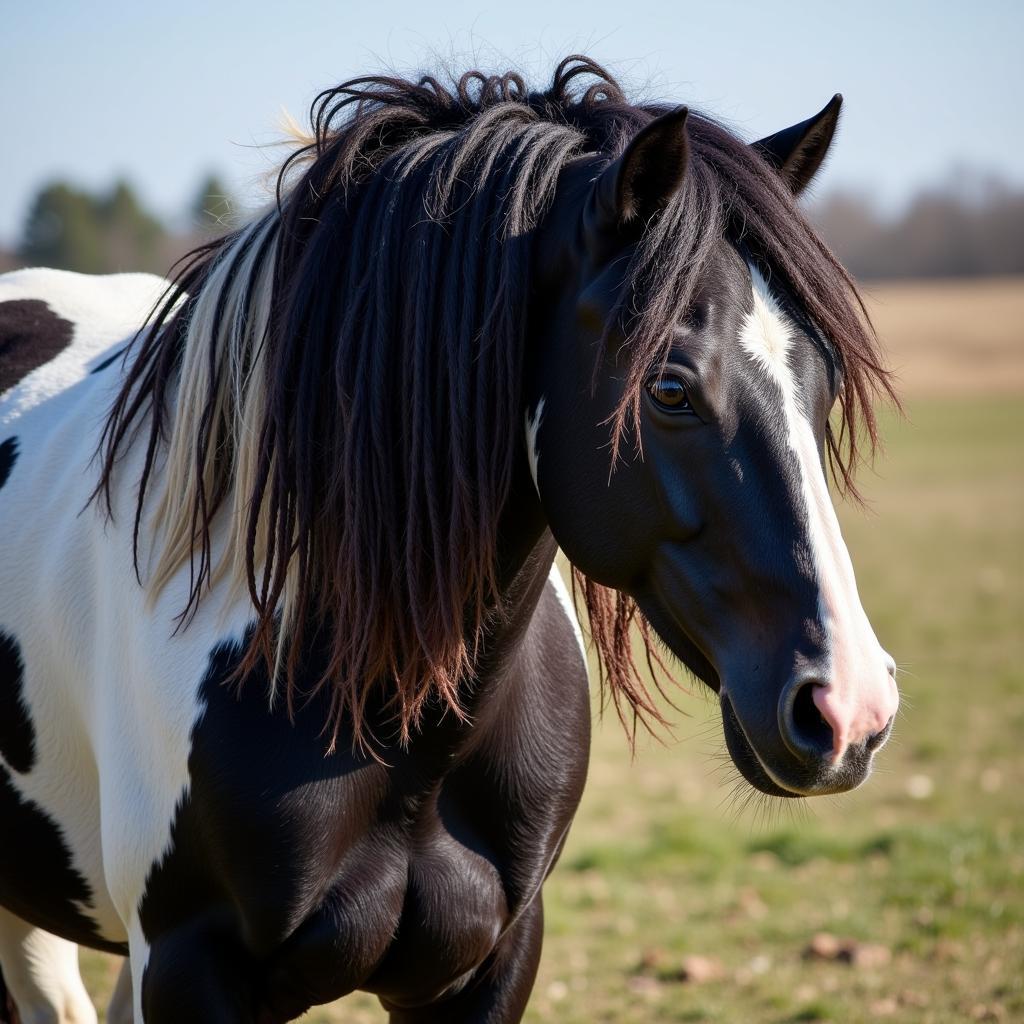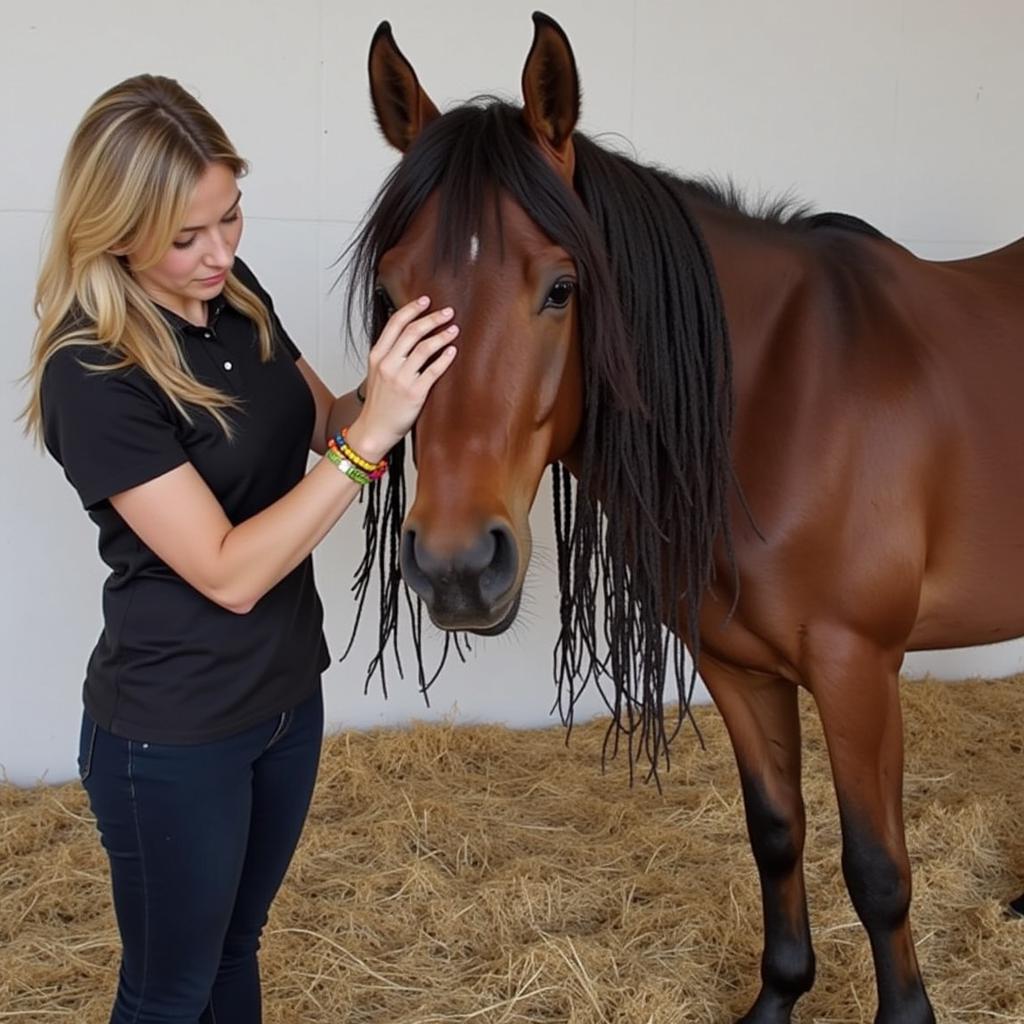Horses With Dreadlocks, a captivating and sometimes perplexing sight, often spark curiosity. These unique equine hairstyles, technically called “corded manes and tails,” are not always natural. While some breeds are genetically predisposed to develop them, more often than not, they are a result of meticulous grooming and maintenance. Let’s delve deeper into the world of these magnificent creatures and understand the intricacies of their remarkable hair.
Decoding the Dreadlocks: Natural or Nurtured?
The appearance of dreadlocks in horses can stem from two primary sources: genetics and dedicated care. Certain breeds, such as the Gypsy Vanner horse, are known for their thick, flowing manes and tails that, if left untended, naturally form into cords. This natural tendency is a part of their breed standard and contributes to their majestic appearance.
However, the vast majority of horses with dreadlocks achieve this look through deliberate grooming practices. Owners painstakingly separate and twist the hairs, a process that can take years to achieve the desired length and thickness. This commitment to creating and maintaining corded manes and tails is a testament to the owner’s dedication and the horse’s patience.
The Gypsy Vanner Horse: A Breed Predisposed to Cords
Gypsy Vanners are often considered the epitome of horses with dreadlocks. Their abundant, wavy hair naturally lends itself to cording, and these horses often sport impressive manes and tails that nearly sweep the ground. This characteristic is a highly valued trait within the breed, further cementing the association between Gypsy Vanners and the dreadlock aesthetic.
 Gypsy Vanner horse displaying its impressive natural dreadlocks
Gypsy Vanner horse displaying its impressive natural dreadlocks
The Art of Cultivating Equine Dreadlocks
For breeds that don’t naturally develop dreadlocks, the process requires considerable effort. It involves separating the hair into small sections and twisting them regularly to encourage the formation of tight cords. This can be a time-consuming process, often taking years to achieve long, well-defined dreadlocks. The maintenance doesn’t stop there, as the cords require regular cleaning and careful handling to prevent breakage.
 Grooming a horse's mane to create dreadlocks
Grooming a horse's mane to create dreadlocks
Caring for Corded Manes and Tails: A Labor of Love
Maintaining a horse’s dreadlocks is a significant undertaking. The cords require meticulous cleaning to remove dirt and debris. Washing too frequently can weaken the cords, while infrequent washing can lead to buildup and tangles. Finding the right balance is key to maintaining healthy and aesthetically pleasing dreadlocks.
Washing and Drying: A Delicate Balance
Washing a corded mane and tail requires specialized shampoos and conditioners. Owners often opt for gentle, natural products to avoid damaging the hair. Drying the cords can also be a lengthy process, as they retain moisture easily and must be thoroughly dried to prevent mildew and other issues.
 Washing and drying a horse's dreadlocks.
Washing and drying a horse's dreadlocks.
Are Dreadlocks Harmful to Horses?
A common concern is whether dreadlocks are detrimental to a horse’s well-being. When properly cared for, they pose no harm. In fact, for breeds like the Gypsy Vanner, corded manes and tails are considered a desirable trait. However, neglecting the meticulous grooming requirements can lead to matting, tangles, and skin irritation.
Conclusion: Appreciating the Beauty of Horses with Dreadlocks
Horses with dreadlocks are a testament to the beauty and versatility of equine hair. Whether naturally occurring or meticulously crafted, these unique hairstyles add to the allure and mystique of these magnificent creatures. Proper care and understanding are essential for maintaining the health and beauty of these striking manes and tails. Remember, if you’re considering giving your horse dreadlocks, commit to the long-term care they require.
FAQs:
- Do all horses get dreadlocks? No, only certain breeds, like the Gypsy Vanner, naturally develop corded manes and tails.
- How long does it take to create dreadlocks on a horse? It can take several years to achieve long, well-defined dreadlocks through grooming.
- Can dreadlocks harm a horse? No, when properly cared for, dreadlocks pose no threat to a horse’s well-being.
- How do you wash a horse with dreadlocks? Use gentle shampoos and conditioners, and ensure thorough drying to prevent mildew.
- What breeds are known for their dreadlocks? The Gypsy Vanner horse is most commonly associated with naturally corded manes and tails.
- Are there any special tools needed for maintaining dreadlocks? Yes, specific combs and brushes are helpful for separating and twisting the hair.
- Can I remove dreadlocks from my horse? Yes, but it’s a time-consuming process and may require professional grooming assistance.
For any further assistance or inquiries about horses and pet care, contact us at Phone Number: 0772127271, Email: [email protected] or visit us at QGM2+WX2, Vị Trung, Vị Thuỷ, Hậu Giang, Việt Nam. We have a 24/7 customer service team.